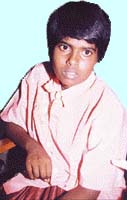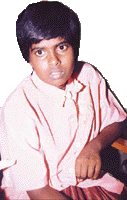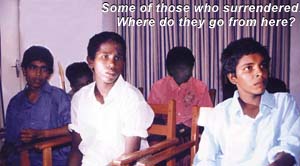 |
 11th October 1998 |
Front Page| |
 They want to live |
Contents
|
|
 |
They want to liveBy Ayesha R. RafiqShattered dreams and hopes, uncertain fu- tures are all that lie ahead for them. At a time when many children are obsessed with their Nike shoes, fancy cars and who is throwing the next party, these children's pleas for peace and happiness, a family and safety, seem almost out of place. Ironically, their wishes are harder to grant. Where do they go from here? Whom do they turn to? What international charter will protect them? What children's rights do they have? Do they have to spend the rest of their lives hiding in fear, wondering not only where their next meal will come from, but also whether the next life this war will claim will be theirs? And how many deaths will it take till we know, that too many people have died? These children are fighting another's war. They are out there in the battlefront, forced to fight for a cause they don't believe in, doing something even adults would cower at the very thought of. Are they prisoners of war, or just little children? They are the LTTE child cadres. Eighteen of them surrendered during the Mankulam attack, not knowing what else to do when they were cornered, or too injured to escape. They wanted to live- so they didn't bite the cyanide which hung around their necks. The boys dressed in sarongs and shirts, and the girls in skirts and blouses, they walked into the room, shuffling their feet, none wanting to be the first in line, when the media met them in Colombo last week. Many kept their heads bent low as they passed us, looking scared and confused, not knowing what lay in store for them. They cowered down, trying to hide their faces from the incessantly flashing lights of the cameras. But some of them were too young to know. One little boy, a 13-year-old and the youngest of the group, was quite cheerful once his initial nervousness wore off. He kept grinning every few seconds, equally at ease with the army and the media personnel, whose microphones he willingly held towards his colleagues behind him as they tried to answer all the questions fired at them. He seemed to think he was a star. Maybe he will still get over what happened that hot afternoon peddling his bicycle back home from school. He doesn't remember when he was recruited to the LTTE. But that day in Mullaitivu the LTTE accosted him and three others, and forcibly recruited them. "I wanted to see my parents, but the LTTE told me I would never be able to see them again," he said. His father, who he says is a drunkard, works abroad. His mother died a long time ago. He knows she committed suicide by taking poison, but he doesn't know why. After his recruitment, he was trained in Kilaikulam for one-and-a-half months, in the use of grenades. But he says he has never used one in battle. He, like many of the children there, was mainly in the supplies division, involved in the cooking and supply of food to the troops at the battlefront. But that didn't prevent him from getting hurt. He was in a bunker, when it was bombed by the army. He still sports the dressing on his left hand, which covers a wound caused by shrapnel. Does it hurt? No, he says, with all the courage that his 13 years can muster, but then he falters, and says the bigger wound on his shoulder still hurts. He surrendered to the army when he was cornered. "I raised my hands," he says, demonstrating the action to us. "The other four who were with me ran away. I didn't want to die. So I surrendered." Hisdog-tag carried the number 982, he says. Recruits are only given numbers once they are fully trained and regarded as fully fledged members of the group. Another, a 14-year-old had joined the LTTE in 1995. His father had died some years ago, and his brother was shot dead by the army. So he decided to join the LTTE in 1995. Once the training was over, they were given only one set of clothes, and not looked after well, he says. "I didn't know what I was getting into when I first joined. My parents didn't know what I was doing or where I was." There were around 15-20 others his age in his battalion. "Everyone who was with me ran away when they saw the army approaching, but I was too scared to run, so I stayed and surrendered." Only six of the children had actually used weapons in war. For most it was their first time in battle, and that too in the role of cooks. Many of them were trained for one-and-a-half months, to use AK-47's and T-56's, 60mm mortars, and the like. Had anyone killed a soldier? No, they all answered, terribly anxious to set this one point straight with all of us. "I know how to handle a weapon, but I have never killed anyone, another 16-year-old said. What did he think of the idea of fighting for a separate state? He voiced what almost all of the others told us when he said he rejected the idea, and thought that the war was something unnecessary, started by Prabakharan, or 'Thalaivar', as they refer to him. "I think all the people should live together, all we want is peace."
A 14-year-old girl, (there were four girls in all) says she was forcibly recruited to the LTTE. The LTTE had come to her home one day and told them that one of the family would have to join the cause. As both her brothers were younger, she had no choice but to discontinue school and join the LTTE, in May this year. She was given one month's training with a T-56 weapon in Malavi, by a 20-year-old named Kavitha. The Mankulam attack was her first time in battle. She says that there are 'medics' to take care of the injured, but that
very often this care is inadequate. With childish confidence, she says
that her family will come to Colombo to be with her. She knows that if
she goes back to them, she will be killed. She would like to begin school
from where she left off at Grade 9. What happens to those who try to run
away and are caught?, we asked them, eager for any scrap of information
they could hand us. "They are beaten and kept in jail. Then they will
be sent on frontline duty for as long as five years," said one 15-year-old
whose big toe had been blown off in the attack.
These are the true casualties of war. What will happen to them now? "We will look into it," is all the army has said so far. Now it's time to lend a helping hand to the children, to their future, our future, in return for all the pain and the grief that society has dealt out to them. It's our lives, not just theirs, we will be saving.
More Plus * Ceylon connection in Dickens' unfinished tale
Front Page| News/Comment| Editorial/Opinion| Business| Sports | Mirror Magazine |
|
 |
Please send your comments and suggestions on this web site to |
|

